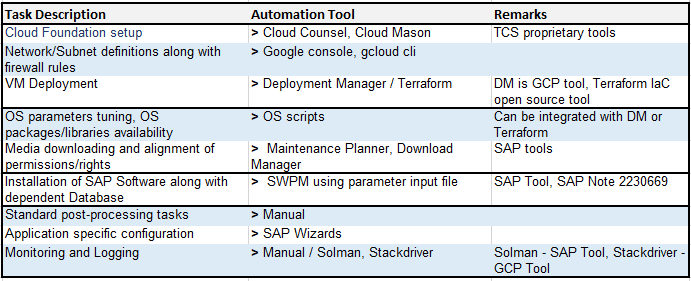Abstract
In today’s Cloud Computing world “Automation” is the buzz word. Cloud Automation refers to methodology, tools and software solutions that automate the provisioning, installation, configuration and management of the cloud resources & services. Benefits of cloud automation are reduction of manual efforts for repetitive tasks, faster deployment with better control, enhanced security & and of course reduced costs.
Though we come across the key word “End-to-End Automation” but there is a caveat and in real world not all the tasks w.r.t. SAP Deployment on Cloud can be automated fully and we do perform few steps manually in order to accomplish the task.
This paper focuses on identifying the automation opportunities and tools for deployment of SAP Applications and the underlying Infra components on Google Cloud.
Tasks Buckets
For any SAP Application deployment in Google Cloud, we can bucket the major tasks as below:
> Cloud Foundation setup
> Network/Subnet definitions along with firewall rules
> Hostnames and IP addressing schemes
> Access to GCP Foundation
> Provisioning of Cloud Infra objects (VM, ILB, GCS)
- SAP Application Pre-processing
> OS parameters tuning
> OS packages/libraries availability
> Media downloading and alignment of permissions/rights on files and target
> Installation of SAP Software along with dependent Database
- SAP Application Post-processing
> Standard post-processing tasks
> Application specific configuration
> Monitoring setup
Scenarios
We explored the automation opportunities for these two common scenarios of deploying SAP Application on GCP as shown below. The tool or process may vary depending upon the exact deployment requirement and needed configuration.
Scenario-1 : Standard installation of SAP NW on DB (Oracle, DB2, HANA, ASE, MS SQL) on a single VM, suitable for most of the Non-PRD tiers where we keep all the application components on a single node/VM to reduce the Infra footprint and the cost.

Scenario-2 : Distributed installation of SAP NW 7.5 on HANA DB 2.0 SPS05 on multiple VMs with HA cluster for ASCS and Database, where performance and availability of PRD tier is of utmost importance for the Enterprise to run business smoothly.

Benefits
- Template based deployment: Template enables to create, update and delete an entire stack on-demand as a single unit instead of managing resources individually. Automation scripts or configuration files used for Infra provisioning and SAP Applications deployment can be aligned with minimum changes to have similar setups.
- Extra and better control: It will allow to build and implement policies in cloud footprint right from the start. It gives better control over processes and policies to amend changes whenever required.
- Factory foundation: Universal Templates for each major phase will lay foundation for Factory model. Automation will help to establish and refine the model for performing repetitive deployments with similar or changed configurations.
- Reduced cost, Better RoI : Automation with consistent processes and faster deployment will result in increased efficiency, reduced cost and in turn better return on investment.
Please do share your thoughts and feedback.
Cheers !
